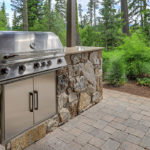What Is The Difference Between Limestone And Sandstone?
What Sets Limestone Apart From Sandstone
Limestone and sandstone are not all that unusual. In fact, they can actually be found all around the world. Their uses vary from home accents to practical flooring options. Limestone and sandstone are often seen as the gorgeous backdrop of a number of the dramatic landscapes and breathtaking scenic views you can discover both across North America, and around the world. As sedimentary rocks, they have a number of similarities. When looked at more closely, however, their composition and formation actually do set them apart from one another. So, what’s the actual difference between limestone and sandstone?
Limestone and Sandstone Composition
In general, limestone is defined as being composed of calcium carbonate. Calcium carbonate often comes from plant and animal skeletons and remnants including the shells of mollusks. Sandstone, on the other hand, is not described as coming from any one substance. It consists of sand sized debris, which variety from .0063 mm to 2 mm in size, and often (but not always) includes quartz. Sandstone is often composed of different elements that make up one large rock or surface like feldspar, mica, lithic fragments, and biogenic debris like shells.
Formation of Limestone and Sandstone
Limestone is formed from once living organisms that are usually full of decomposed calcium carbonate. These organisms include mollusks, echinoids, and corals. Limestone is found in beds, and most limestone beds form in marine environments in which big deposits of organisms and carbonate precipitation build up over the years, like an ocean or large lake. Sandstone is shaped from the breakdown of larger rocks due to weathering and erosion as well as from processes that occur inside the rock, usually biologic but now and again chemical in nature.
Classification of Limestone Vs Sandstone
Sandstone is often categorized based totally on the composition and kind of grain it consists of in large quantity. Ferruginous sandstone, for example, denotes excessive iron content in its material composition. More superior classifications, utilized by geologists, combine descriptions of texture and composition. Limestone can be informally described by the sort of carbonate it consists of—along with calcite, aragonite, and dolomite. Geologists use more complex classifications to describe limestone based totally on texture, formation, and composition.
How Limestone and Sandstone Appear
Many sedimentary rocks, including sandstone, display a visible stratification into layers. This visual cue can help determine how a rock came to be primarily based at the size and intensity of each layer. Limestone does not have the stratification pattern that sandstone does. Some limestone is composed completely of organic matter that is impossible to see with just the naked eye.
A Few Fun Stone Filled Facts
Weathering of limestone has created a few dramatic landscapes. The Kwangsi Region of Southern China has phenomenal limestone formations formed by the submersion of limestone in water that created caves and caverns. Carlsbad Caverns in New Mexico is yet another spectacular collection of limestone caves. The amazing stalactites and stalagmites located in such caves are due to the dripping of water containing dissolved calcium carbonate. These are just a few examples of cool limestone facts—there are definitely a lot more to learn.
















